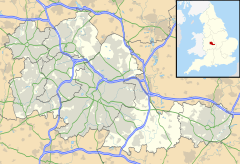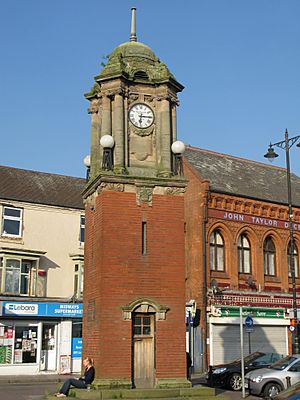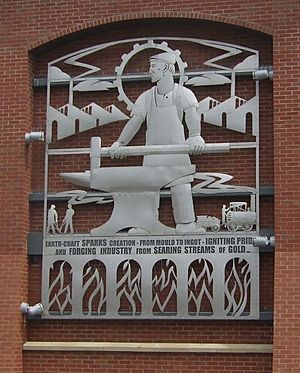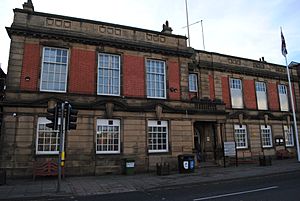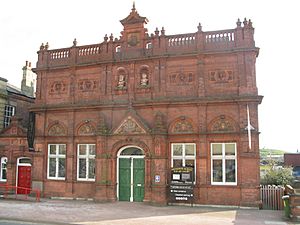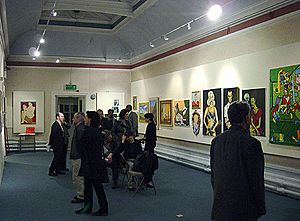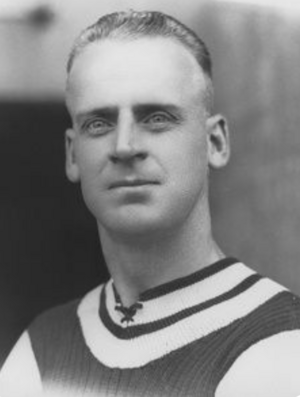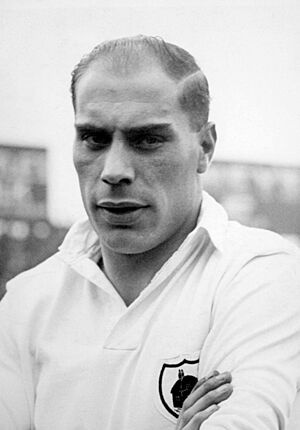Wednesbury facts for kids
Quick facts for kids Wednesbury |
|
|---|---|
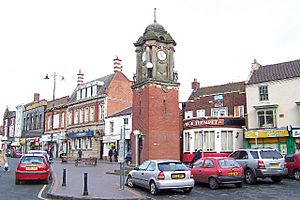 Wednesbury High Street |
|
| Population | 20,313 (2021 Census BUA Profile) |
| OS grid reference | SO9895 |
| • London | 125.9m |
| Metropolitan borough |
|
| Metropolitan county | |
| Region | |
| Country | England |
| Sovereign state | United Kingdom |
| Post town | WEDNESBURY |
| Postcode district | WS10 |
| Dialling code | 0121 |
| Police | West Midlands |
| Fire | West Midlands |
| Ambulance | West Midlands |
| EU Parliament | West Midlands |
| UK Parliament |
|
Wednesbury is a market town in the Sandwell area of the West Midlands, England. It used to be part of Staffordshire. The town is close to where the River Tame begins. It is also part of the Black Country, an area known for its industrial past.
Wednesbury is about 5 miles (8km) south-east of Wolverhampton. It is also 3 miles (4.4km) south-west of Walsall and 7 miles (11.8km) north-west of Birmingham. In 2021, the town had a population of 20,313 people.
Contents
History
Early History and Medieval Times
In 2008, archaeologists found parts of a large ditch in St Mary's Road. This ditch was very old, even older than the Early Medieval period. Experts think it was part of a hilltop fort from the Iron Age.
The name "Wednesbury" comes from "Wodensbyri," first written in 1004. It means "Woden's borough." Woden was an important god in old English beliefs before Christianity.
It is believed that two battles happened in Wednesbury during the Anglo-Saxon period. One was in 592 and another in 715. The Anglo-Saxon Chronicle mentions a "great slaughter" in 592. In 715, a battle took place between Mercia (where Wednesbury was) and Wessex.
Æthelflæd, also known as the Lady of Mercia, made Wednesbury stronger. She was the daughter of Alfred the Great. She built five forts to protect against the Danes, and Wednesbury was one of them. Wednesbury's fort was likely an older one made stronger with stone and wood. It probably had earth walls and water-filled ditches. A plaque in the gardens near St Bartholomew's church says that stones from the old fort were used there.
In 1086, the Domesday Book called Wednesbury "Wadnesberie." It was a busy farming village that included areas like Bloxwich and Shelfield. For a long time, the king owned the town. Later, it was passed to the Heronville family.
Medieval Wednesbury was a small farming village. In 1315, coal pits were first recorded, creating more jobs. People also made nails. William Paget, who was born in Wednesbury in 1505, became a very important person. He was a Secretary of State and an Ambassador.
Later History
In the 1600s, pottery from Wednesbury, called "Wedgbury ware," was sold far away. White clay from Monway Field was used to make tobacco pipes.
By the 1700s, most people worked in coal mining and nail making. The town grew a lot when the first turnpike road opened in 1727. Canals and later railways also helped the population grow. In 1769, the first Birmingham Canal was built. It connected Wednesbury's coal mines to factories in Birmingham. Soon, factories lined the canal banks.
In 1743, the Methodist movement faced challenges in Wednesbury. John and Charles Wesley preached there and were first welcomed. Later, some people became angry and treated John Wesley badly. However, he remained calm. Eventually, the situation improved. Methodism grew strong in Wednesbury, and Wesley visited often. Important figures like Francis Asbury and Richard Whatcoat attended Methodist meetings here.
Wednesbury became a municipal borough in 1886, meaning it had its own local government. The town hall was its main office. On April 1, 1966, Wednesbury joined with West Bromwich and Walsall. In 1961, the area had 34,511 people.
In 1887, Brunswick Park opened to celebrate Queen Victoria's Golden Jubilee.
20th and 21st Centuries
On January 31, 1916, a German Zeppelin airship bombed Wednesbury during the First World War. A family lost their lives in their home.
The first council houses in Wednesbury were built in the early 1920s. By 1931, over 1,000 council houses were built. By 1959, there were more than 5,000. The Hateley Heath estate, built in the late 1940s and early 1950s, was a large development.
In 1947, a court case involving a cinema in Wednesbury helped create a legal rule. This rule, called "Wednesbury unreasonableness," helps decide if a public body's decision is fair and reasonable.
In 1966, Wednesbury's borough ended. Most of its area became part of West Bromwich. In 1974, West Bromwich joined with Warley to form the Sandwell borough we know today. Wednesbury's postcode is WS10.
During the 1970s and 1980s, Wednesbury's old industries closed, and many people lost their jobs. But since 1990, new developments have changed the town. These include new industrial areas, a retail park, and a pedestrian-only street called Union Street. The traditional market is still busy, and the area around Market Place is now a protected conservation area.
In the late 1980s, land near the M6 motorway was chosen for shops. Ikea opened its superstore there in January 1991. The retail park grew with more large shops. After a difficult period around 2009, most shops were busy again by 2012. The retail park expanded in 2017 with more shops and restaurants.
Wednesbury was affected by two sad events in the late 1900s. In December 1977, four children died in a house fire during a firefighters' strike. In September 1984, four students and a teacher from Stuart Bathurst RC High School died when a roll of steel fell from a lorry onto their minibus.
For over 100 years, the huge Patent Shaft steel works was a major part of Wednesbury. It opened in the 1800s and closed in 1980. The factory was taken down in 1983. Now, the land is used for light industry. The factory's iron gates are still on a traffic island in the town.
In 2003, the Wednesbury Museum and Art Gallery hosted "Stuck in Wednesbury." This was the first public art show for the Stuckism art movement.
The historical records for Wednesbury Borough are kept at Sandwell Community History and Archives Service in Smethwick.
Transport History
Wednesbury has been connected to the rail network since the mid-1800s.
The South Staffordshire Line served Wednesbury until 1993. Passenger trains stopped in 1964. A steel terminal opened on the site but closed in 1992. The railway line itself closed in 1993.
Until 1972, the town also had the Great Western Railway line. This line connected Wednesbury to Birmingham and Wolverhampton. Passenger trains stopped running on this line in 1972. The line was later used to create the West Midlands Metro tram system, which opened in May 1999.
A steam tram service to Dudley started in 1884. It became electric in 1907 but stopped running in 1930. Buses replaced it.
The town's current bus station was rebuilt and opened in 2004.
Oakeswell Hall
Oakeswell Hall was an important house in Wednesbury. William Byng built it around 1421. Later, the Jennyns family owned it. In 1707, Richard Parkes, an iron maker, bought the house. It was a farmhouse in the late 1700s and early 1800s. Joseph Smith, the first town clerk, owned it later and restored it. Sadly, the hall was taken down in 1962.
Dr. Walter Chancellor Garman and his wife, Margaret Frances Magill, lived at Oakeswell Hall. Their children included the Garman sisters, who were connected to the Bloomsbury Group. There were nine children in total.
Demography
In the 2021 census, Wednesbury's population was 20,313. Here's a look at the different ethnic groups and religions:
| : Wednesbury: 2021 Census | |||||||||||||
| Ethnic group | Population | % | |||||||||||
|---|---|---|---|---|---|---|---|---|---|---|---|---|---|
| White | 15,594 | 76.7% | |||||||||||
| Asian or Asian British | 3,109 | 15.3% | |||||||||||
| Black or Black British | 713 | 3.5% | |||||||||||
| Mixed | 591 | 2.9% | |||||||||||
| Other Ethnic Group | 229 | 1.1% | |||||||||||
| Arab | 82 | 0.3% | |||||||||||
| Total | 20,313 | 100% | |||||||||||
The religious makeup of the area in the 2021 Census was:
| Wednesbury: Religion: 2021 Census | |||||||||||||
| Religious | Population | % | |||||||||||
|---|---|---|---|---|---|---|---|---|---|---|---|---|---|
| Christian | 9,657 | 50.1% | |||||||||||
| Irreligious | 6,389 | 33.1% | |||||||||||
| Muslim | 2,008 | 10.4% | |||||||||||
| Sikh | 673 | 3.5% | |||||||||||
| Hindu | 424 | 2.2% | |||||||||||
| Other religion | 80 | 0.4% | |||||||||||
| Buddhist | 52 | 0.3% | |||||||||||
| Jewish | 1 | 0.1% | |||||||||||
| Total | 20,313 | 100% | |||||||||||
Transport
Roads
Wednesbury is on Thomas Telford's old London to Holyhead road. This road was built in the early 1800s. A section of the road was made wider in 1997. This completed the Black Country Spine Road, which had been under construction since 1995.
Buses
The bus station in the town centre was rebuilt in 2004. From here, you can catch buses to Wolverhampton, West Bromwich, Walsall, and Dudley. You can also connect to the Merry Hill Shopping Centre and Birmingham.
Railways
Since 1999, Wednesbury has had the West Midlands Metro tram system. There are stops at Great Western Street and Wednesbury Parkway. The tram runs from Wolverhampton to Birmingham. The place where trams are maintained is also in Wednesbury.
Wednesbury's tram links are set to get even better. A new Metro tram line is being built to Brierley Hill, going through Tipton and Dudley. This new line uses the old South Staffordshire Line. The first part of this extension to Dudley is expected to open in 2025.
Districts
- Church Hill: This area is near the town centre. It is known for St Bartholomew's Church.
- Brunswick: Located just north of the town centre. Most of it was built around Brunswick Park in the early 1900s.
- Friar Park: This area was originally part of West Bromwich. It was built in the late 1920s and early 1930s.
- Myvod Estate: About a mile north of the town centre, towards Walsall. It was built in the 1920s as one of Wednesbury's first big council housing areas.
- Wood Green: This area is around the A461 road, heading towards Walsall. Important places include Stuart Bathurst RC High School and Wood Green Academy. The local church is St Paul's. Since 1990, a large shopping area has grown here.
- Golf Links: Most of this area was built in the 1940s and 1950s. It has both private and council homes and is in the south of the town.
- Woods Estate: To the north-east of the town centre. Most of the houses here were built by the council between 1930 and 1962.
- King's Hill: Located north of the town centre.
Wards
- Wednesbury North: Includes Wednesbury Central, Wood Green & Old Park.
- Wednesbury South: Includes Hill Top, Ocker Hill (part), Golf Links, Millfields, Harvills Hawthorn.
- Friar Park: Includes Woods & Mesty Croft, Friar Park.
Media
Local news and TV shows come from BBC West Midlands and ITV Central. TV signals are received from the Sutton Coldfield TV transmitter.
Local radio stations include BBC Radio WM, Heart West Midlands, Smooth West Midlands, Hits Radio Black Country & Shropshire, Greatest Hits Radio Birmingham & The West Midlands, Greatest Hits Radio Black Country & Shropshire, and Black Country Radio.
The town has local newspapers like the Wednesbury Herald and the Express & Star.
Schools
- Tameside Primary Academy
- Park Hill Primary School
- St Mary’s Roman Catholic Primary School
- Old Park Primary School
- St John's Primary Academy
- Stuart Bathurst Catholic High School
- Wodensborough Ormiston Academy
- Wood Green Academy
- Mesty Croft Academy
Notable People
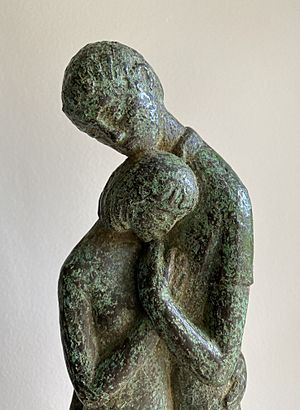
- William Paget (1506–1563), a statesman and accountant.
- Moses Haughton the elder (around 1734 – 1804), an engraver, designer, and painter.
- Richard Whatcoat (1736–1806), who became the third bishop of the American Methodist Episcopal Church.
- Moses Haughton the younger (1773–1849), an engraver and painter, known for small portraits.
- John Brotherton (1829–1917), a tube maker and Mayor of Wolverhampton.
- John Ashley Kilvert (1833–1920), a soldier in the Charge of the Light Brigade, later Mayor of Wednesbury.
- Wilson Lloyd (1835–1908), an iron founder and Member of Parliament for Wednesbury twice.
- The Garman Sisters (around 1900-around 1975), members of the Bloomsbury Group, lived at Oakeswell Hall.
- Gwynneth Holt (1909–1995), an artist known for her ivory sculptures.
- Kathleen Margaret Midwinter (1909–1995), the first female Clerk of the House of Commons.
- Henry Treece (1911–1966), a poet and writer, mostly of historical novels for children.
- Richard Wattis (1912–1975), a character actor.
- Kevin Laffan (1922–2003), a screenwriter and author who created the TV show Emmerdale.
- Peter Archer, Baron Archer of Sandwell (1926–2012), a lawyer and Member of Parliament.
- Jon Brookes (around 1945–2013), drummer for The Charlatans.
- Alex Lester (born 1956), a BBC Radio 2 broadcaster.
- David Howarth (born 1958), a politician and Member of Parliament.
- Karl Shuker (born 1959), a zoologist, cryptozoologist, and author.
- Lee Payne (born 1960), founding bassist and songwriter for the band Cloven Hoof.
- Baga Chipz (born 1989), a drag queen and TV personality.
Sport
- Billy Malpass (1867–1939), a footballer who played for Wolves.
- Marty Hogan (1869–1923), a baseball player and manager.
- Fred Shinton (1883–1923), a footballer who played for The Albion and Leicester City.
- Billy Walker (1897–1964), a footballer for Aston Villa and England. He later managed Nottingham Forest.
- Syd Gibbons (1907–1953), a footballer who played for Fulham.
- Jack Burkitt (1926–2003), a footballer who played for Nottingham Forest.
- Roy Proverbs (1932–2017), a footballer who played mainly for Gillingham.
- Wilf Carter (1933–2013), a footballer who played mainly for Plymouth Argyle.
- Norman Deeley (1933–2007), a footballer who played for Wolves.
- Gordon Wills (1934–2018), a footballer who played for Notts County and Leicester City.
- Johnny Gill (born 1941), a footballer who played mainly for Hartlepool United.
- Alan Hinton (born 1942), a footballer who played for Derby County.
- Roy Cross (born 1947), a footballer who played mainly for Port Vale.
- Brian Caswell (born 1956), a footballer who played for Walsall.
- John Thomas (born 1958), a footballer.
- Aaron Williams (born 1993), a footballer.
Notable Employers
Current Employers
- Property developers J.J. Gallagher bought most of the old Lloyd factory site in 1988. After preparing the land, it was ready for large shops. IKEA bought the former F.H. Lloyd steel plant from Triplex in 1988. They opened one of their first British stores there in January 1991.
- Morrisons opened a supermarket in the town centre on November 4, 2007. This created about 350 new jobs. Some old council bungalows and shops were taken down to build it.
- Quantum Print and Packaging Limited moved to Wednesbury in 2013. They employ 30 people at their 30,000 square foot factory in the town centre.
- In 2016, the German supermarket chain Lidl opened a new distribution centre. It is located near Junction 9 Retail Park.
- MSC Industrial Supply is a major company that provides metalworking and maintenance products and services.
Former Employers
- Patent Shaft steelworks opened in 1840. It served the town for 140 years before closing on April 17, 1980. The factory was taken down in 1983.
- Metro Cammell (Metropolitan Company) started business in 1902. They made railway coach bodies, turntables, bridges, and railway wagons. The plant stayed open until 1964. The work moved to Birmingham, and the site was sold.
- F.H. Lloyd steelworks started in the 1880s. It provided jobs for about 100 years. However, F.H. Lloyd closed in 1982. Triplex Iron Foundry took over the site but kept it open for only six years. It was then sold to IKEA in 1988 and taken down to build the superstore.
- A Cargo Club supermarket opened in July 1994. It was one of only three such stores in Britain. The business was not successful and closed by the end of 1995.
Images for kids
See also
 In Spanish: Wednesbury para niños
In Spanish: Wednesbury para niños


